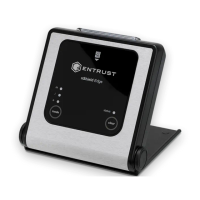-P, --port=PORT
Specifies the port to use when connecting to the
given nShield Connect (default 9004).
-n, --ntoken-esn=ESN Specifies the ESN of the nToken to be used to
authenticate this client. If the option is omitted, then
software authentication will be used instead.
9.3.1.2. config-serverstartup
The config-serverstartup command-line utility automatically edits the [server_startup]
section in the local hardserver configuration file in order to enable TCP ports for Java
and KeySafe. Any fields for which values are not specified remain unchanged. After
making any changes you are prompted to restart the hardserver.
Run config-serverstartup using the following commands:
config-serverstartup [OPTIONS]
For more information about the options available to use with config-serverstartup, run
the command:
config-serverstartup --help
9.3.2. Configuring a client to communicate through an nToken
You can configure a client to use its nToken to communicate with an nShield Connect, if
it has one installed. When this happens, the nShield Connect:
•
Examines the IP address of the client.
•
Requires the client to identify itself using a signing key.
If an nToken is installed in a client, it can be used to both generate and
protect a key that is then used for the impath communication between
the nShield Connect and the client. A strongly protected key is used at
both ends of the impath as a result.
9.3.3. Enrolling the client from the command line
Complete the following steps to initially configure a client computer to communicate
with and use an nShield Connect. See Basic nShield Connect, RFS and client
configuration for more about the available options.
nShield® Connect Installation Guide 48 of 73

